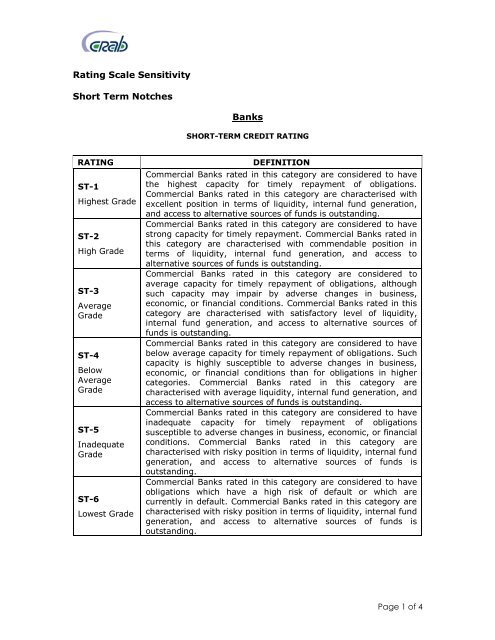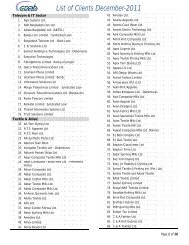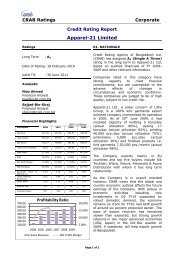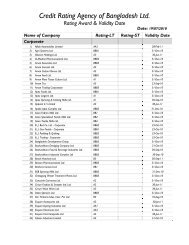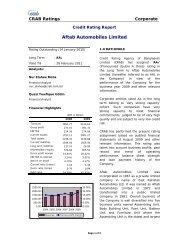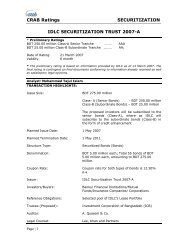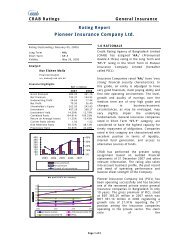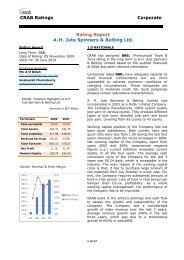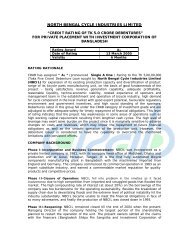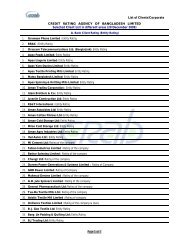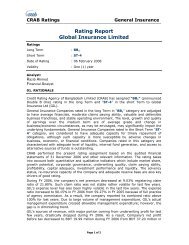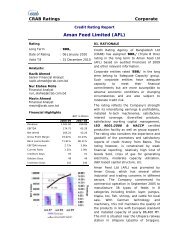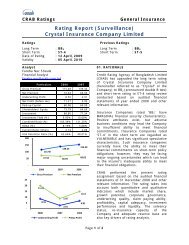CRAB Short Term Rating Scale
CRAB Short Term Rating Scale
CRAB Short Term Rating Scale
Create successful ePaper yourself
Turn your PDF publications into a flip-book with our unique Google optimized e-Paper software.
<strong>Rating</strong> <strong>Scale</strong> Sensitivity<br />
<strong>Short</strong> <strong>Term</strong> Notches<br />
Banks<br />
SHORT-TERM CREDIT RATING<br />
RATING<br />
ST-1<br />
Highest Grade<br />
ST-2<br />
High Grade<br />
ST-3<br />
Average<br />
Grade<br />
ST-4<br />
Below<br />
Average<br />
Grade<br />
ST-5<br />
Inadequate<br />
Grade<br />
ST-6<br />
Lowest Grade<br />
DEFINITION<br />
Commercial Banks rated in this category are considered to have<br />
the highest capacity for timely repayment of obligations.<br />
Commercial Banks rated in this category are characterised with<br />
excellent position in terms of liquidity, internal fund generation,<br />
and access to alternative sources of funds is outstanding.<br />
Commercial Banks rated in this category are considered to have<br />
strong capacity for timely repayment. Commercial Banks rated in<br />
this category are characterised with commendable position in<br />
terms of liquidity, internal fund generation, and access to<br />
alternative sources of funds is outstanding.<br />
Commercial Banks rated in this category are considered to<br />
average capacity for timely repayment of obligations, although<br />
such capacity may impair by adverse changes in business,<br />
economic, or financial conditions. Commercial Banks rated in this<br />
category are characterised with satisfactory level of liquidity,<br />
internal fund generation, and access to alternative sources of<br />
funds is outstanding.<br />
Commercial Banks rated in this category are considered to have<br />
below average capacity for timely repayment of obligations. Such<br />
capacity is highly susceptible to adverse changes in business,<br />
economic, or financial conditions than for obligations in higher<br />
categories. Commercial Banks rated in this category are<br />
characterised with average liquidity, internal fund generation, and<br />
access to alternative sources of funds is outstanding.<br />
Commercial Banks rated in this category are considered to have<br />
inadequate capacity for timely repayment of obligations<br />
susceptible to adverse changes in business, economic, or financial<br />
conditions. Commercial Banks rated in this category are<br />
characterised with risky position in terms of liquidity, internal fund<br />
generation, and access to alternative sources of funds is<br />
outstanding.<br />
Commercial Banks rated in this category are considered to have<br />
obligations which have a high risk of default or which are<br />
currently in default. Commercial Banks rated in this category are<br />
characterised with risky position in terms of liquidity, internal fund<br />
generation, and access to alternative sources of funds is<br />
outstanding.<br />
Page 1 of 4
Financial Institutions<br />
SHORT-TERM CREDIT RATING<br />
RATING<br />
ST-1<br />
Highest Grade<br />
ST-2<br />
High Grade<br />
ST-3<br />
Average<br />
Grade<br />
ST-4<br />
Below<br />
Average<br />
Grade<br />
ST-5<br />
Inadequate<br />
Grade<br />
ST-6<br />
Lowest Grade<br />
DEFINITION<br />
Financial Institutes rated in this category are considered to have<br />
the highest capacity for timely repayment of obligations. Financial<br />
Institutes rated in this category are characterised with excellent<br />
position in terms of liquidity, internal fund generation, and access<br />
to alternative sources of funds is outstanding.<br />
Financial Institutes rated in this category are considered to have<br />
strong capacity for timely repayment. Financial Institutes rated in<br />
this category are characterised with commendable position in<br />
terms of liquidity, internal fund generation, and access to<br />
alternative sources of funds is outstanding.<br />
Financial Institutes rated in this category are considered to<br />
average capacity for timely repayment of obligations, although<br />
such capacity may impair by adverse changes in business,<br />
economic, or financial conditions. Financial Institutes rated in this<br />
category are characterised with satisfactory level of liquidity,<br />
internal fund generation, and access to alternative sources of<br />
funds is outstanding.<br />
Financial Institutes rated in this category are considered to have<br />
below average capacity for timely repayment of obligations. Such<br />
capacity is highly susceptible to adverse changes in business,<br />
economic, or financial conditions than for obligations in higher<br />
categories. Financial Institutes rated in this category are<br />
characterised with average liquidity, internal fund generation, and<br />
access to alternative sources of funds is outstanding.<br />
Financial Institutes rated in this category are considered to have<br />
inadequate capacity for timely repayment of obligations<br />
susceptible to adverse changes in business, economic, or financial<br />
conditions. Financial Institutes rated in this category are<br />
characterised with risky position in terms of liquidity, internal fund<br />
generation, and access to alternative sources of funds is<br />
outstanding.<br />
Financial Institutes rated in this category are considered to have<br />
obligations which have a high risk of default or which are<br />
currently in default. Financial Institutes rated in this category are<br />
characterised with risky position in terms of liquidity, internal fund<br />
generation, and access to alternative sources of funds is<br />
outstanding.<br />
Page 2 of 4
Insurance Companies<br />
SHORT-TERM CREDIT RATING<br />
RATING<br />
ST-1<br />
ST-2<br />
ST-3<br />
ST-4<br />
ST-5<br />
ST -6<br />
DEFINITION<br />
Insurance companies rated ‘ST 1’ have STRONG ability to meet<br />
their financial commitments on short-term policy obligations.<br />
They are rated in the highest category by <strong>CRAB</strong>.<br />
Insurance companies rated ‘ST 2’ have a GOOD ability to meet<br />
their financial commitments on short-term policy obligations.<br />
However, they are somewhat more susceptible to the adverse<br />
effects of changes in circumstances and economic conditions<br />
than insurers in the highest rating category.<br />
Insurance Companies rated ‘ST 3’ have an ADEQUATE ability to<br />
meet their financial commitments on short-term policy<br />
obligations. However, adverse economic conditions or changing<br />
circumstances are more likely to lead to a weakened ability of<br />
the insurers to meet their financial obligations.<br />
Insurance Companies rated ‘ST 4’ are regarded as VULNERABLE<br />
and has significant speculative characteristics. The insurance<br />
companies currently have the ability to meet their financial<br />
commitments on short-term policy obligations; however, they<br />
may be facing major ongoing uncertainties which can lead to the<br />
insurer’s inadequate ability to meet their financial obligations.<br />
Insurance Companies rated ‘ST 5’ are regarded as CURRENTLY<br />
VULNERABLE to non-payment and are dependent upon<br />
favourable business, financial, and economic conditions for them<br />
to meet their financial commitments on short-term policy<br />
obligations.<br />
Insurance Companies rated ‘ST 6’ are considered to have<br />
Obligations which have a high risk of DEFAULT or which are<br />
currently in default.<br />
Page 3 of 4
Corporate<br />
SHORT-TERM CREDIT RATING<br />
RATING<br />
ST-1<br />
ST-2<br />
ST-3<br />
ST-4<br />
ST-5<br />
ST -6<br />
DEFINITION<br />
<strong>Rating</strong> indicates that entity’s/issuer’s capacity to meet its<br />
financial commitment on the obligation is strong<br />
Rated entity/issuer is susceptible to adverse economic<br />
conditions however the obligor's capacity to meet its<br />
financial commitment on the obligation is satisfactory<br />
Adverse economic conditions are likely to weaken the<br />
entity’s/issuer’s capacity to meet its financial commitment<br />
on the obligation<br />
Entity/issuer has significant speculative characteristics.<br />
The obligor currently has the capacity to meet its financial<br />
obligation but faces major ongoing uncertainties that could<br />
impact its financial commitment on the obligation.<br />
Entity/issuer currently vulnerable to nonpayment and is<br />
dependent upon favourable business, financial and<br />
economic conditions for the obligor to meet its financial<br />
commitment on the obligation.<br />
Entity/issuer is in payment default. Obligation not made on<br />
due date and grace period may not have expired. The<br />
rating is also used upon the filing of a bankruptcy petition.<br />
Page 4 of 4


